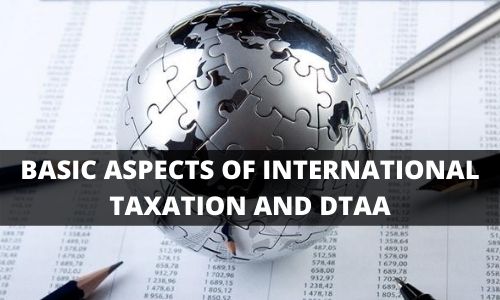In 1991, the New Economic Policy (NEP) is launched, one of the important parts of this policy is globalization by which economies of various countries came across for trade. Through globalization came into effect various cross border transactions has incurred. Now by globalization and liberalization, the whole world becomes a new village. Integration between economies become increasing. So as the result of the transactions across the countries now the income is not restricted to only national boundaries but also from international boundaries.

It becomes necessary to account for all the foreign incomes and pay the tax as per the provisions of the Act. Due to the earning of foreign incomes, international taxation has come into effect and its taxation in the resident state as well as in the foreign state (global state). That is why, DTAA provisions under the Income Tax Act, 1961 comes into effect. Technically, there is no concept as of international taxation but for convenience, we say, the international aspect of income tax laws of a particular nation as international taxation.
What is DTAA?
DTAA is also a treaty and the Treaty is also explained in the Vienna Convention on the law of tax treaties 1969.
An international taxation agreement is a contract between the states which is governed by international law which can either in a single instrument or its particular designation.
It is an agreement between the two or more countries on will tax shall be imposed. In addition to this, the terms and conditions of the contract have to be strictly followed.
In other words, DTAA is an agreement between the countries for resolving the tax issues of income and this agreement increases the transparency and also works on tax evasion.
Significance of DTAA:-
The highlights of DTAA are as follows:-
1. Avoidance of double taxation in both countries.
2. For recovery of tax from the other country.
3. Fairly distribute the taxing rights between the countries.
4. Increased transparency of tax evasion.
Nature of DTAA:-
DTAA can be either comprehensive or limited.
1. Comprehensive- It levies a tax on capital gains, capital, and taxes on income. In addition to this, it assures that both countries pay equal tax as per the provision.
2. Limited- it levies taxes on income from shipping, air transport, or inheritance and gift. It imposed taxes on the limited source of income.
Models of Tax Treaty:-
There are major three models of the treaty:-
1. Organization for Economic Cooperation and Development.
2. United Nations Model
3. US Model
The agreement is made as per the consent of both countries. While drafting the agreement one of the above models must be agreed by both the parties. In addition to this, the parties can add freely other clauses that are not specified in the model. These models provide connivance in drafting the agreement of DTAA.
It is not compulsory to copy all the clauses of the models. India in its agreement with the international states add various clauses and also deletes the clauses which are not specified in the model which results in a different agreement between countries. So, it is not compulsory to make as same as the model. The above models are just model not
treaty.
Applicability of DTAA:-
The tax treaty is applicable to both the parties agreed to enter into an agreement. For establishing the applicability you need to understand the concept of residence.
Residence:-
The residence is divided into 2 parts:-
1. For individuals:-
An individual is liable to tax according to his residence, Place of incorporation, Place of management but excludes the one who is liable to tax in respect only of income from the source in that particular state.
It can be concluded from the above that one of the person resident one of the contracting states then, the provision of the treaty shall be applicable.
Sometimes create the confusion that who will pay the tax of the global income and various issues of taxability arises when the person becomes the resident of two or more states.
A person who becomes a resident of two or more states. then, he shall be called as a dual resident. Such residency is known as dual residency.
But it is the need of the hour that the dual residency needs to be broken and the individual must assign a single residency.
2. For legal entities or corporations:-
The test of residency of legal entities and corporations is their place of effective management or place of the incorporation.
Place of incorporation is the most reliable test to know the place of residency of the business entity or the legal entity as the case may be. It has the why the place of incorporation is the most reliable place of the business because the place of incorporation of business can not be changed over the time, it shall be fixed over the lifetime while the place of business can be changed as per the changing time that’s why the place of incorporation is more reliable than a place of business.
Place of effective management is less certain as now business entity change their place of business and this will create problems and confusion.
This is how we determine the residency of the person whether he is of any domicile and once he becomes the resident of one of the states he can apply for the avoidance of
double taxation.
General interpretations of principles:-
1. Treaty or the agreement shall be made as per the consent of the parties, the terms and conditions must have the permission of both the states.
2. If in the agreement there is more than one language is then, there is one interpretation that can be understood by both the states.
3. Tax treaties must be relieving in addition to that it also must not impose the tax.
4. There must be a literal and broad interpretation of the language of the agreement.
5. It is presumed that words which are not explained in the treaty shall mean as per the domestic law of the state.
6. This agreement is made to avoid double taxation and relief from the payment of the tax imposed by the domestic laws of the state.
7. If there is ambiguity in the provisions of the treaty then, the interpretation that must be adopted should be harmonious for both the states.
Determination of DTAA:-
There are several models of DTAA are available so, some steps must be followed which DTAA is applicable which are as follows:-
Step 1- income of the transaction is taxable under the Income Tax Act, 1961.
Step2- whether if one of the parties is a resident outside India or any Foreign company.
Step 3- residential status must be determined.
Step 4- a treaty between the parties in which one of the parties is Indian resident and other is Foreign company or resident outside India.
Conclusion:-
The increasing transaction with the other countries or cross border transactions increases the scope and working of corporate professionals like CA CS and CMA. In this type of issue, advice of the corporate professionals are also
required which also widened their scope. The complications in DTAA are also day by day increasing like which model of DTAA must be applied and incidental matters. In the future, taxation will more be focused on international taxation aspects.


